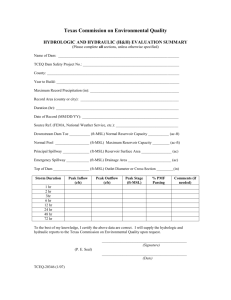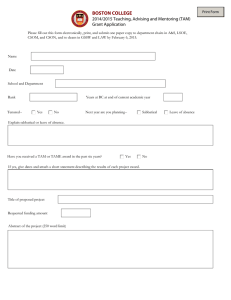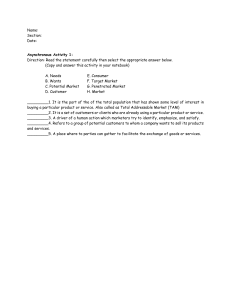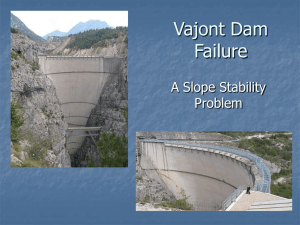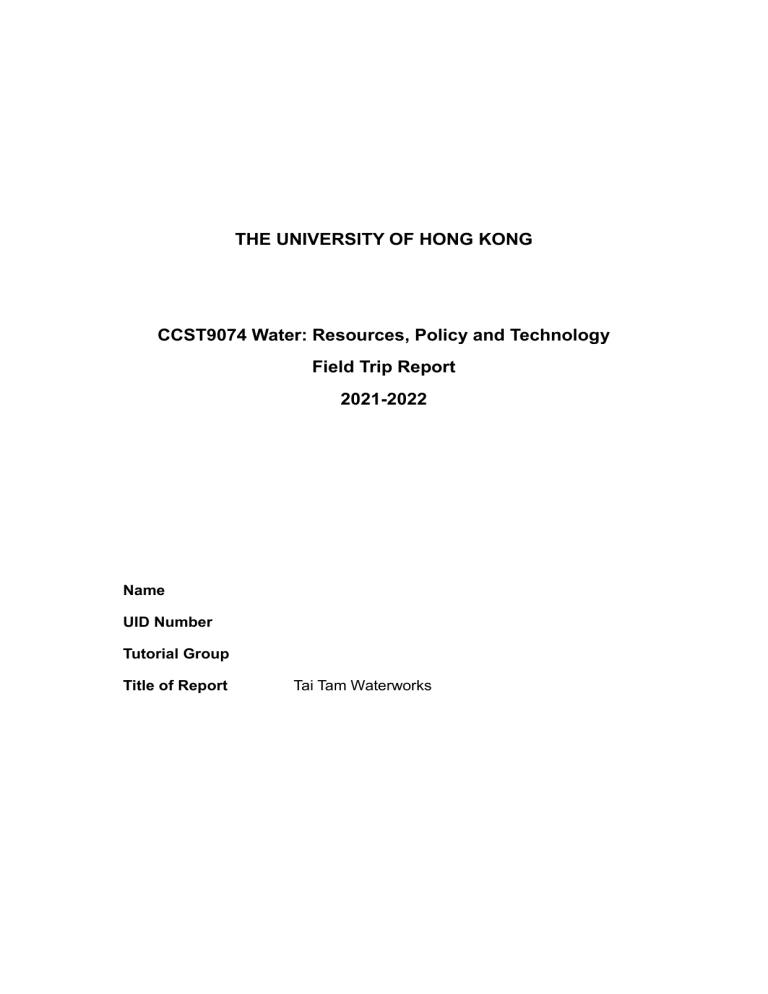
THE UNIVERSITY OF HONG KONG CCST9074 Water: Resources, Policy and Technology Field Trip Report 2021-2022 Name UID Number Tutorial Group Title of Report Tai Tam Waterworks iVacAir With the ever-growing demand on water supply in Hong Kong, strategically planned development was carried out from time to time. These water supply and treatment system are found to be started in the mid-eighties. With the virtual field trip, a chance to Tai Tam Waterworks was provided. The Heritage of Water Infrastructures opens a whole new chapter of water supply system in 1850s and has proved to be an integral part of nowadays water supply network. In this report, several main structure of the reservoir, dam and pumping system will be discussed. Reservoir Structure The Tai Tam Upper Reservoir, Tai Tam Byewash Reservoir, Tai Tam Intermediate Reservoir and Tai Tam Tuk Reservoir were built in several stages, all now are monuments with high historic value. They are proved to be very effective water saving facilities in the water supply system. As mentioned in the virtual field trip, masonry bridges and aqueduct were built which the piers and columns hardened by moulded capitals or corbels to provide the best support (Figure 1). The usage of concrete corbels is very common in connecting precast concrete structures. Experiments show that by testing the corbel strength and cracking between column and corbel, a reinforcement in the form of a loop provides the best performance to decrease probability of cracks. [1] This can be found on both masonry bridge and masonry aqueduct (Figure 2). Dam Structure The reservoir dam stores water before gravitationally transferring water through tunnels to Central district. Granite was chosen as the main material for Upper Reservoir Dam construction (Figure 3) whereas concrete was chosen later for the Byewash Reservoir Dam and Tai Tam Tuk Reservoir Dam (Figure 4). Granite fragments has a lower strength and will deteriorate faster when comparing to concrete. The choice of using concrete in later stage of the Tai Tam Group of Reservoirs shows the knowledge of material engineers at that time. On each dam, valve house is found mainly built by rock-faced rusticated granite (Figure 5). These houses are built on projecting platforms, serving as the inspection location of the dam and control center for the dam valves. Water Pumping System Structure The Tai Tam Tuk Raw Water Pumping Station plays the important role of pumping water to the city center (Figure 6). By then, steam drive pumps were the key to perform the task. According to Figure 7, the pump works under the energy conservation from the cylindrical tank B, passing the movable beam E to the water pump rod R. After the steam enters the tank from A, water is injected from V1. The steam condenses, pressure inside the tank reduces and a vacuum is created. Under atmospheric pressure, the piston (P1) will be forced down and lift the pump rod on the other side. Water will then be pumped out. [2] This water pumping mechanism is well-known as the Newcomen engine. Overall, the civil structures and systems of Tai Tam Group of Reservoirs shows remarkable engineering techniques at that time. Till now, the reservoirs are preserved and remains in good conditions. Acting as one of the main water supply systems for Hong Kong Island, the Tai Tam Group of Reservoirs should be protected and promoted. It is hoped that more people will learn to admire the water supply complexity and learn to save water. Figure List Figure 1 Hardened Structures by Moulded Capitals or Corbels Figure 2 Corbels found on Tai Tam Upper Reservoir Masonry Bridge Figure 3 Tai Tam Upper Reservoir Dam with Granite Structure Figure 4 Masonry-faced Concrete Tai Tam Tuk Reservoir Dam Figure 5 Rock-faced Rusticated Granite Valve House Figure 6 Tai Tam Tuk Raw Water Pumping Station Figure 7 Newcomen Engine Reference List [1] de Lima Araújo, D., de Oliveira, E. M., Silva, E. M. O., Coelho, S. A., & El Debs, M. K. (2021). Experimental analysis of a modified two-step corbel for precast concrete system. Engineering Structures, 242, 112585. [2] Sam M. (2019). Earliest steam engines used to pump water.
![[ ] Mr SIN Kim-wai](http://s2.studylib.net/store/data/015368496_1-be7d1bb6b784fa9df1eb2f16b7296053-300x300.png)
